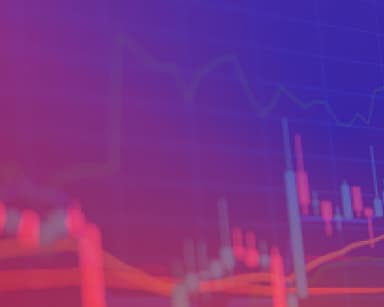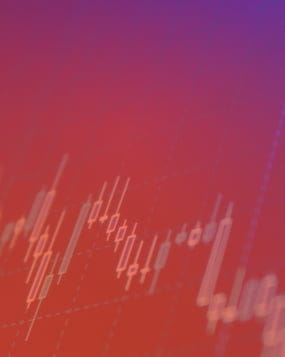- What’s the difference between CFDs and investing?
- Benefits of CFDs
- How to start CFD trading
- Benefits of investing
- CFD vs investing example
- Which is best for me?
What’s the difference between CFDs and investing?
CFDs and investing are two separate ways to take a position on a market’s price movements. On the surface, that makes them seem similar – but they work in very different ways. Because unlike investing, with CFD trading you don’t ever own the asset you’re trading.
How investing works
When you invest in a market (such as a stock), you usually buy it and add it to your portfolio.
Then, when the time comes to close your position you sell it on and collect the difference in its price as profit – unless you have to sell it for a loss.
How CFDs work
When you trade a market via CFDs, you don’t buy it and add it to your portfolio. Instead, you buy a contract for difference (CFD). This is a type of financial product that tracks the live price of a specific financial asset, such as a stock, index or forex pair.
When you close your position, you’ll exchange the difference in the asset’s price with your provider. If it’s gone up, you’ll earn a profit. If it’s fallen, you’ll earn a loss.
Learn more about CFDs.
Benefits of CFD trading
Let’s take a look at three major benefits of CFD trading: leverage, going short and the range of markets available.
Leverage
When you buy a CFD, you don’t necessarily have to pay for the full price of your position upfront.
As you can see, the end result from both transactions is the same. For example, buying 50 Apple CFDs gives you the same exposure as buying 50 Apple shares. But because you never own the underlying asset with CFDs, you can access some useful benefits for active traders.
Let’s return to our Apple example above. If Apple is trading at $150, then buying 50 shares would cost $7,500. With investing, you’ll need to pay that full $7,500 to buy the shares. With CFDs, you might only need 10% of your position’s price in your account – in this instance, $750.
Despite only putting down 10% of your position’s total value, your profit or loss is still based on its full size. So you can earn 100% of a transaction’s gains – or losses.
Going short
So far, we’ve only looked at going long by buying markets with CFDs. But because you don’t own the underlying asset, you’re not limited to long positions with contracts for difference. You can go short by selling a market at the outset instead.
Shorting gives you a position that will profit if the underlying asset price falls instead of rising. It can be a useful method of targeting returns in bearish conditions.
It is technically possible to go short when share dealing. But for most investors, it’s a complex process that involves borrowing and reselling stocks. With CFDs, the process is the same as going long – you just choose ‘sell’ instead of ‘buy’.
What can I trade?
With share dealing, you can only access a narrow range of asset classes: typically shares and ETFs.
With CFDs, on the other hand, you can deal in a vast range of markets: forex, commodities, stock indices, shares, ETFs and more. For example, City Index offers over 6000 global CFD markets. Using a single platform and account, you can take your position on Amazon, Wall Street, gold and much more.
To see our full range of markets – and trade them risk free – open a demo account.
How to start CFD trading
Follow these five steps to start trading CFDs with City Index today:
- Open a live account to trade CFDs with real funds, or a demo account to develop your skills with virtual capital
- Add funds using debit or credit card, PayNow or bank transfer
- Choose a market from the 1000s available
- Buy (go long) if you think your market’s price will rise or sell (go short) if you believe it will fall
- Execute your trade, remembering to use stops and limits to control your risk
Benefits of trading shares vs shares CFDs
CFDs are a powerful tool, but they aren’t for everyone. Let’s take a look at some key benefits of investing over CFD trading.
Lower risk
When you trade on leverage, you’re essentially amplifying your exposure without committing extra capital. While this has the potential to increase your profits, it will also increase your losses, which makes CFD trading riskier than investing – although you can limit your risk with stop losses and take profits.
No overnight financing
When you keep a long CFD position open overnight, you’ll pay interest on the leverage you’ve used. So for long-term positions, investing can be more cost effective.
CFDs are often popular with active traders who might only keep positions open for hours or days. Investors, on the other hand, are mostly more passive.
Shares CFDs vs Shares trading example
The easiest way to understand the difference between CFDs and share dealing is with an example.
Let’s say ABC plc is trading with a sell/buy price of $1.30/$1.32, and you want to open a long position.
Trading ABC CFDs
You decide to buy 1000 ABC CFDs because you think the company’s price will rise.
The CFD for ABC has a margin rate of 10%, which means you need 10% of the position’s total value in your account to open the trade. 1,000 x 1.32 is $1,320, so your margin is $132.
ABC stock rises to a sell/buy price of $1.37/$1.39. You close your position by selling at $1.37 (the new sell price).
ABC has moved 5 points ($1.32 to $1.37) in your favour. Multiplied by your position’s size (1,000 units), your gross profit is $50. You’d pay commission to open and close the trade, which would lower your total profit.
If ABC had fallen 5 points to a sell price of $1.27, you’d have lost $50 (plus commission).
Investing in ABC shares
You buy 1000 ABC shares with share dealing.
You’re investing, so you need to buy the shares outright. To buy 1,000 shares in company ABC, you’d need $1,320.
If ABC hits $1.37/$1.39, then you can sell your shares for $1,370, earning you a $50 gross profit.
Again, your total profit would be $50 minus any commissions or broker fees.
If ABC had fallen five points you’d lose $50.
Shares CFD trading vs share trading, which is better for me?
Now we know the benefits of both products, you should be able to choose which you want to get started with. To help you out, here’s a quick recap:
CFDs might be for you if you want:
- Access to over 6000+ markets, including forex, commodities, indices, shares and more
- To trade on leverage
- The option to go short as well as long
Share dealing might be for you if you:
- Are happy sticking to global stocks and ETFs
- Are comfortable committing to the full value of the position upfront
- Want to take ownership of the asset
FAQs
Can you lose more than you invest in a CFD?
Yes. As CFD trading involves trading on margin, there is the possibility that you could lose more than your initial deposit, should markets move against you.
If your account funds drop below 50% of the amount you’re required to keep in your account as margin, then we’ll start automatically closing your positions to prevent your losses from exceeding your deposits.
However, we don’t recommend relying on margin calls for your risk management. You can actively monitor your positions, plus use stops and guaranteed stops to cap your risk before you get close to a margin call.
Learn more about risk management.
Can I vote if I trade a CFD?
No, if you trade a CFD in a company then you won’t get voting rights. A share CFD is a derivative of a stock. Because you don’t actually own the underlying asset, you won’t get voting rights – you only get them if you invest.
Is it better to trade shares CFDs or shares?
Both products and market access have unique features and benefits, and your circumstances and goals are equally individual. Perhaps using the points raised in this article will assist your decision making.









